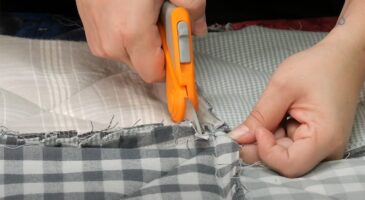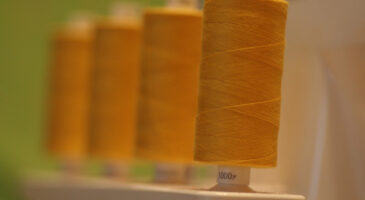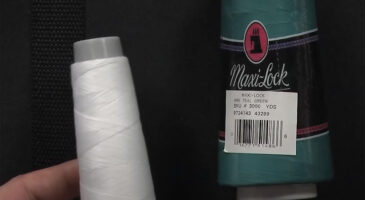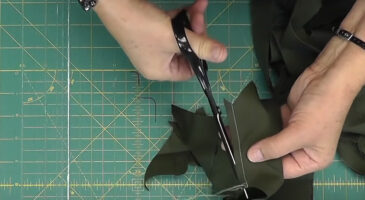Quick Navigation
Some people assume that only having the skills can help you perform a job in the best way possible. Although the assumption is right but only to some extent. A skilled person may be able to get the job done but you must have the right tools so that you can do the work efficiently while being far less tired.
If you only do sewing as a hobby and stitch some clothes or items, you may not need a sewing table although it would be great if you have one. But if you are a professional or do sewing projects that include large fabrics and all, you should have a sewing table as it will help you complete the projects with complete satisfaction while not getting frustrated.

This being said, you may wonder how high your sewing table should be. Well, continue reading this article as it will give you clear-cut answers along with a bunch of useful information as well. We will also talk about important factors to consider while buying a sewing table and in the end, there will be some alternatives as well.
How high should a sewing table be?
28 to 30 inches (2.30-2.50 feet) is the best suitable height for a sewing table because, with this height, you can sit comfortably while your feet will be touching the ground. However, a 28-30 inches table would be great for most people, you should look for a table that comes with an adjustable shelf as well.
This feature gives extra convenience to users as they can place the sewing machine on those shells and then adjust the height to some inches and make it comfortable for them. This thing also helps if people of different heights use a single sewing table.
What is a sewing table called?
The sewing table is widely known by this particular name but it can also be referred to as sewing craft table, cutting table, fabric cutting table, fabric sewing table, etc. A sewing table is just a table made of some material where you put your sewing machine.
In most cases, it doesn’t differentiate from any other regular tables used in libraries or labs. However, some sewing tables come in customized forms which have an adjustable shelf and many other features like this as well.
Should a sewing machine be leveled with the table?
The sewing machine doesn’t have to be leveled with the table as many people simply place their machine on a flat surface and start sewing. However, it is recommended and better practice to have a deep indentation on your sewing table.
Placing your machine in that indentation will level it with the surface of the table. This thing makes it easy for you to thread needles, feed fabric, move fabric positions, and do all other sewing activities.
What should be the dimensions of a sewing machine table?
The standard height of a table is about 30 inches (2.5 feet). As far as length and width are concerned, there is no standard value as it depends on your sewing projects, the space in your room, and what kind of fabric you sew.
If you sew large fabrics and cut them on the table, you may need a table with a bigger length and width. At the same time, you will have to make sure that the table doesn’t look bad and bulky among other furniture in the room, and is not too big that most of its area is just wasting space.
What is the average size of a fabric cutting table?
As said earlier that there is no standard size but the average size of a fabric cutting table is considered to be 48 inches in width, 72 inches in length, and 30 inches in height.
This is an average size but most experts have the opinion that this size is perfect for 97% of the sewing activities as well. With a sewing table of this size, you can easily cut fabric, sew it, and iron it without facing any trouble.
What sewing tables come with a drop-down?
Sewing tables where sewers are supposed to do all the work of sewing projects in a standing position come with a drop-down. This is a great feature as sewers can adjust the table’s height with their machine.
This thing brings convenience and comfort while people of different heights can utilize its benefits without requiring sewing tables of separate sizes for each.
What to consider while buying a sewing machine table?
To make a good decision and get a perfect sewing table for your sewing projects, you need to consider a lot of factors. Although they can vary depending upon sewers’ requirements and types of projects, some of the most essential factors to always considered include the following:
Sewing table size:
Decide what table size you need for your sewing projects. If you only sew small items like cushion covers, doll clothes, and scarves, you may buy a small size table but if you work with large fabric projects, you need a bigger table.
Sturdy sewing table:
Always buy a sewing table made of sturdy material. You mustn’t feel any vibration while operating a sewing machine. Vibration makes the sewing process difficult and it can lead to some errors in your sewing projects as well.
Sewing table storage:
Sewing machine tables should have ledges, drawers, shelves, and other things for storage purposes. You should be able to keep your bobbins, threads, needles, scissors, ribbons, pins, measurement tape, markers, pencils, fabric pieces, and all other accessories on the table.
Adjustable shelf:
Go for a sewing machine with adjustable shelves and other things as it will help you a lot in terms of making yourself comfortable. Also, if you are buying a sewing table for a tailor’s shop, you should only buy adjustable sewing tables, as the sewers can be changed over time and it is not a good idea to buy a new sewing table every time a new sewer comes into work.
Easy to move:
A sewing table should be lightweight so that it can easily be transported from one place to another or can be moved easily from one room to the other. It is an even better idea if you buy a sewing machine table that has small wheels under it as it will take the portability to a higher level.
This is an essential factor for people who don’t have a specific space for sewing projects as they can bring in the table from the garage when they need it and once the project is completed, the sewing machine can be moved back into the garage.
Easy to maintain:
Go for a sewing table that doesn’t require much care and maintenance. Sewing machines come in a wide range of materials and some require far less maintenance than others. You may go for wood or plastic sewing tables as they just need to be cleaned and you may only need to tighten the screws and nails once in a while.
Aesthetic looks:
This factor may seem not so important for some people but it should be considered because you don’t want a sewing table that looks bad among all your beautiful furniture and room theme. You can find sewing tables in different modern as well as classic looks, so take time to decide which look will be better for your room and your satisfaction as well.
What should be the material of the sewing machine table?
Material is the first thing you need to decide and many factors play a role in this decision.
You need to go for a long-lasting material that looks well with your furniture and overall room theme and does not have vibration, or noise as well.
Some of the most common materials used for a sewing machine table include:
- Wood
- Easy maintenance
- Durable
- Sturdy
- Stable
- Long-lasting
- No vibration
- Sound absorbent
- Sustainability
- Particle board
- Classic look
- Does Not dent
- Inexpensive
- Does Not distort
- Lightweight
- Minimum vibration
- Minimal maintenance
- Melamine
- Durable
- Uniform finish
- Low cost
- Large variety
- Plastic
- Inexpensive
- Doesn’t crack
- Lightweight
- Different colors
- Mostly doesn’t get damaged easily
- Metal
- Durable
- Safe
- Long-lasting
- Environment friendly
- Sturdy
- Stable
- Minimum to no maintenance
Best tables for sewing:
- HOMCOM Drop Leaf sewing machine table
- Kangaroo bandicoot sewing and quilting cabinet
- Abacus filing desk comes sewing machine table
- Selena L-shape executive desk for sewing
- The Craft Armoire sewing machine table and cabinet
- Arrow 98611 Gidget II sewing table
- The Brookland storage desk/sewing machine table
- Sew Ready’s sewing machine table
- Tarleton L-Shape desk/sewing machine table
- Arrow 98901 sewing machine table
How to set up a sewing machine on a table?
There is no hard-to-do procedure as most sewing machines come fully assembled. All you need to do is take it out of the box and put it on the table or in the deep indentation on your sewing machine table.
Sewing machines that don’t come fully assembled, you can assemble them easily by looking at instructions on the user manual and then placing them on the sewing table.
What can I use as a sewing table alternative?
You are not bound to only sew clothes while your machine is sitting on a sewing table. You can go with other options that are widely used in different parts of the world. Some major alternatives include:
- Kitchen table
- Dining room table
- Book library table
- Room floor
- Chair with no arms
- Stool
- Sitting bench
- A small shelf
Whatever you choose, it should be sturdy and solid because if there is a vibration or the surface is moving up and down, sewing will become too difficult and may cause errors as well.
Frequently Asked Questions
How tall should a quilting table be?
Although you can do sewing and quilting on the same sewing table, experts believe that a quilting table should be a little bit higher (4-6 inches) than a sewing machine. This is just a suggestion but you can go with a sewing machine table as it will save cost and space as well.
Can I use a sewing machine on the floor?
Yes, you can use a sewing machine on the floor and almost 50% of the sewers around the world sew clothes in this way. You may feel uncomfortable for some time but this practice is considered good to speed up the sewing process while making it easy as well.
You can sit in a position while laying one leg on the floor, the second knee standing right in front of your chest. If you have a machine that requires a foot to control the speed and all, you can use the foot of the standing knee and get things going.



